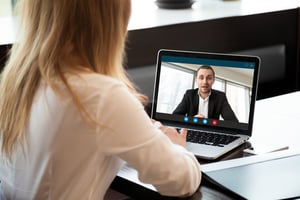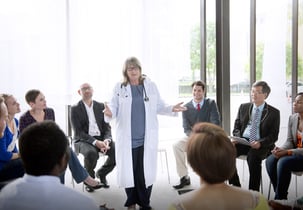Flipped learning uses blended learning methods to enhance the learning experience. PineRock has used this learning strategy to support a range of learners and help develop and reinforce skills they need to succeed in their professional work environments. The training experience is designed to deliver knowledge acquisition as pre-work. PineRock then follows up with live workshop time to activate learning through experiential activities. How do learners achieve more effective outcomes through flipped learning? This blog explains how PineRock’s flipped learning strategy is different than traditional methods and why it is important.
The Evolution of Flipped Learning
Flipped learning and the flipped classroom emerged in K-12 education, made its way to the university level and now is being utilized by the corporate world. In traditional corporate workshops learners' first contact with new ideas happens in the live workshop through direct instruction from the facilitator. After exposure to the basics, learners are asked to complete assignments outside of the live workshops to tackle the most difficult tasks in learning like application, analysis, synthesis, and creativity.
This points to a problem with a traditional workshop. There is insufficient time to engage in meaningful workshop activities if the knowledge to be used had just been learned. The material that forms the basis of the activities is too new and it is not fully processed by the learners.
PineRock’s flipped learning programs reverse the traditional training model by first providing knowledge acquisition opportunities to learners outside the work environment and before coming to and engaging in workshops. Using this early retention strategy allows more time in the workshops to explore difficult, higher-level tasks with peers. Workshop facilitators provide more guidance than lectures. As a result, PineRock has found that live workshops become collaborative learning labs where behavior change and skill development can be accomplished.
What is it?
Five aspects of flipped learning are notable and help us understand the impact of the flipped learning model.
- Learner autonomy - When adult learners plan ahead, and process assigned content they know what they are responsible for. This gives them autonomy and a sense of responsibility
- Teamwork - When teams work together on activities, peer to peer learning supports deeper learning, creativity and better outcomes
- Problem-solving skills - Facilitators provide guidance and encourage live workshop participants to solve problems together. The collaborative opportunities and experience allow participants to gain from the whole team’s contributions. Solving problems together supports more creative solutions
- Communication skills – Using knowledge during application activities in the live workshop portion of the flipped classroom requires communication of concepts. Guidance and mentorship from the workshop facilitator and peer feedback during activities improve learner communications
- Enjoyment and creativity - Learners want to feel competent. Giving them the opportunity to first learn the content and then come prepared to the workshop to improve skills, is more enjoyable than traditional listening and note taking and it supports better outcomes.
How does it work?
The flipped learning strategy delivers content in advance of a live workshop. Learning outside the work environment is often made up of online content delivered through custom video content.  Learners also can collaborate with peers online both synchronously and asynchronously, through connected discussions and explorations to learn the content. Readings and pushed content are also important elements in the learning process. These forms of blended learning are an ideal approach for providing pre-work and video content. Once the pre-work is complete and learners arrive at an event and/or learning session, the flipped part of this strategy enables learners to better participate in workshop activities and pull through the new knowledge they learned previously.
Learners also can collaborate with peers online both synchronously and asynchronously, through connected discussions and explorations to learn the content. Readings and pushed content are also important elements in the learning process. These forms of blended learning are an ideal approach for providing pre-work and video content. Once the pre-work is complete and learners arrive at an event and/or learning session, the flipped part of this strategy enables learners to better participate in workshop activities and pull through the new knowledge they learned previously.
Benefits of a flipped classroom
- Shifts initial learning of content to a space outside of the work environment which allows increased future face-to-face time to be used to focus on verbalization and/or topic exploration and in greater depth
- Changes facilitator roles from lecturer to guide and mentor during the “active” learning portions of workshops
- Utilizes active learning (i.e., an instructional method or strategy that engages students in meaningful learning activities) that require them to think about what they are doing by involvement in activities
- Enables deeper learning through experiential activities which enhance a personal understanding of the material rather than simple retention of knowledge
- Enables more active learning time with facilitator or guide which might include workshop activities ranging from using customer profiles to develop new sales strategies to practicing new presentation content, professional document analysis, and skill development and practice
- Encourages personal “buy-in” or investment by each learner in the overall process
How does PineRock implement flipped learning?
PineRock has used many ways to blend the pre-work portion of flipped learning through technology solutions. PineRock can help you record your videos or record audio segments or we can do it all for you. We typically provide presentation notes along with video or audio so that learners who prefer to read can download the transcript. To keep learners’ attention, videos should be less than 20 minutes in length.
Since these presentations are delivered online, they will most likely not be shown again in the face-to-face workshop. Our curriculum development team can create a review and a knowledge-based quiz for the start of the live workshop phase. It is often a good way to ensure everyone has the same relative knowledge base going into the live workshops. The results of the quizzes provide information that can be used to plan remediation before the workshop activities begin. Then the workshops can be focused on active and collaborative assignments.
Case Study: Pharmaceutical New Hire Sales Training
PineRock has worked with multiple pharmaceutical companies to help them define their learning programs for product launches, national sales meetings and internal training both online and face-to-face. Recently, we were asked by a pharma client to revise their training program for new hires taking into account product updates and identifying technologies that would give them ways to use the face-to-face time more efficiently. They needed their new sales representatives to be better prepared and active in the field more quickly.
PineRock had previously produced high-quality scientific, clinical, and training content for many clients and had significant experience in the scientific content specific to this client. In providing services to this particular client our instructional sales training team used their experience in designing, developing, and delivering instructionally-sound learning solutions. We defined everything from the ideal learning platform to the interactive, creative, immersive and engaging e-learning modules.
We added a social overlay for the work to be done before the learners came to the live training. As a result, we increased communications where previously learners were expected to consume the content through rote memorization. We increased teamwork by adding interactions with facilitators during the pre-onsite learning.  The social connections were critical to an early understanding of the application of their studies. Once the learners arrived on-site, they not only knew others in their cohort, but they had shared experience with the content they could draw on as they worked together at the live training. In short, we created a flipped learning program for new hires.
The social connections were critical to an early understanding of the application of their studies. Once the learners arrived on-site, they not only knew others in their cohort, but they had shared experience with the content they could draw on as they worked together at the live training. In short, we created a flipped learning program for new hires.
Assessments are critical to any training initiative. In this flipped learning we created assessments to increase learner autonomy by give them a sense of his or her own development and achievement. It also highlighted areas for remediation and reinforcement.
The approach to technology utilized a blend of tools. Much of the early content was delivered through a Learning Management System (LMS) using video, high-end graphics, and audio driven guidance through the learning. The platform also enabled communications between learners and their facilitators through tools like asynchronous communications for participants to post thoughts and questions and a synchronous tool to enable online conferences. We brought physicians to the learners through both video and live synchronous presentations to tell patient stories from a real-world perspective. This allowed the client’s sales force to be able to link the core science they were learning to example customers and their customers’ patients.  By flipping the learning, we were able to simultaneously support the participants’ learning of complex content and how it would be applied in their work lives. When learners arrived at the live workshops they were prepared and had already begun the difficult task of applying the content to their verbalization's and role-playing. The client was able to shorten the pre-work by 33% and the onsite time by 20%.
By flipping the learning, we were able to simultaneously support the participants’ learning of complex content and how it would be applied in their work lives. When learners arrived at the live workshops they were prepared and had already begun the difficult task of applying the content to their verbalization's and role-playing. The client was able to shorten the pre-work by 33% and the onsite time by 20%.
Why the Flipped Classroom Works
Analysis of the impact of inverting knowledge acquisition as a precursor to live workshops has demonstrated that the flipped classroom produces positive impacts on learning for participants.
 When live workshop activities are refocused around active learning strategies, face-to-face time is used more efficiently, and it is beneficial to learners, facilitators and employers. Both the stronger and weaker participants benefit from the technologies and active learning strategies adopted in flipped learning.
When live workshop activities are refocused around active learning strategies, face-to-face time is used more efficiently, and it is beneficial to learners, facilitators and employers. Both the stronger and weaker participants benefit from the technologies and active learning strategies adopted in flipped learning.
Flipped learning is not just a re-branding of old techniques, it is a significant change from conventional learning methods. It is a strategy that enables equal access to learning for a range of learners. It supports lifelong learning skills and helps learners prepare to be more collaborative and more responsible for their own learning. Through skilled curriculum development PineRock provides support for all learners as they apply concepts in challenging group work like role-plays, games and assessments with real customers. Flipped learning helps all learners be successful through active collaboration, critical reading and thinking, learning concepts, and self-regulation needed for their next phase in corporate training.
PineRock has tremendous experience in creating effective learning and performance programs. From retention strategies, analytics and measurement to live workshop execution and systematic check-ins and follow-up application in the field, PineRock’s instructional designers ensure instructionally sound content is learned first, so that onsite application workshops are effective.
Interested in learning more about PineRock's Learning & Performance offering? Please click the button below.




